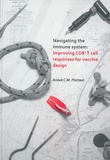Navigating the immune system
Improving CD8+ T cell responses for vaccine design
Summary
This thesis can roughly be divided into two parts. In the first part we study a new mechanism of antigen processing and its immunological consequences. In a series of two chapters we discuss our research on proteasome-catalyzed peptide splicing (PCPS) and its immunological relevance in Listeria monocytogenes infection. In the last two chapters we focus on modulation of antigen processing in order to enhance CD8+ T cell responses for vaccine design. We first present a complete strategy to increase immunogenicity of a Mycobacterium tuberculosis cDNA encoded antigen and subsequently test this in a heterologous prime-boost vaccination regimen. The latter was done at the Max Planck Institute of Infection Biology in Berlin. These results will be briefly summarized per chapter and are followed by the main conclusions.
In chapter 2 we show how we developed a novel approach to identify spliced epitopes in a bacterial infection. More and more evidence of spliced epitopes is available but due to insufficient tools to predict them, their identification remains challenging. We developed a reverse immunology-based multi-level approach to identify spliced epitopes that are targeted by CD8+ T cells in Listeria monocytogenes infection. Our data show that we can predict such epitopes with high accuracy, and also demonstrate the immunological relevance of PCPS in infection. The spliced epitope-specific CD8+ T cells detected in our studies recognized only the spliced epitopes, not the peptides in their natural flanking residues. This opens a whole range of opportunities for immunotherapies or vaccine design.
We continue with PCPS in studies described in chapter 3. Here, by digestion of substrates with purified 20S proteasomes, we show that PCPS indeed increases the variety of peptides that is produced. Both immuno- and constitutive proteasomes were found to produce spliced peptides next to linear peptides. Furthermore, we show that CD8+ T cells that are activated by a linear epitope derived from a Listeria monocytogenes antigen, can be cross reactive to spliced epitopes that share sequence similarity with the linear epitope and are derived from the same antigen. Such a mechanism may reduce the chances of immune evasion because infected cells can present multiple versions of one epitope that can be recognized by the same CD8+ T cells.
T cell priming by vaccines is often not optimal. We therefore aimed to increase vaccine-specific T cell responses in the studies reported in chapter 4. In this chapter we show a complete strategy to enhance vaccine’ immunogenicity. The multistage cDNA vaccine H56, encoding three secreted Mycobacterium tuberculosis antigens, was used as a model vaccine and delivered using dermal DNA tattoo immunization. We started by predicting H56 epitopes. Their antigen processing was optimized using flanking residue modulation and immunogenicity was increased by linkage of the cDNA of the antigen to cDNA of proteins with immunogenicity enhancing properties. This complete strategy can be used for vaccine design.
The H56 cDNA was also used in studies described in chapter 5, in which we studied the effectiveness of a heterologous prime-boost strategy using dermal H56 DNA tattoo immunization in combination with BCG ::H56 subcutaneous injection. BCG is the only licenced vaccine against TB but it lacks efficacy in certain situations. We therefore tested whether we can successfully boost the effect of BCG by incorporating it in a heterologous prime boost regimen. We first measured the immunization strategies separately and scored cellular and humoral responses as well as efficacy. We continued by testing different combinations of the immunization strategies and scored the same immunological parameters. We conclude that broad immune responses are necessary to fight TB. Heterologous prime-boost using a combination of a dermal H56 cDNA prime and a subcutaneously given BCG ::H56 boost resulted in immune responses associated with protection. We show that responses differ depending on the sequence and type of the immunizations that are given, and that this has consequences for the disease burden.
In conclusion
In this thesis, antigen processing and CD8+ T cell activation was studied. In the first chapters we proved the immunological relevance of PCPS in bacterial infection and in the last chapters we showed a complete vaccination strategy that will contribute to effectively fight Mycobacterium tuberculosis. We can conclude that these results give more insight in how modulation of antigen processing influences immune responses, mainly CD8+ T cells. This knowledge will contribute to improved vaccine design.
